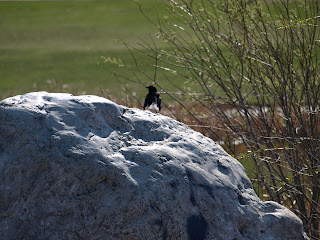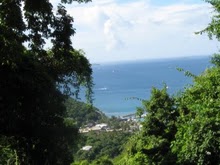 |
| Clinging to the top |
 |
| Red winged Blackbird gliding |
 |
| Many Blackbirds |
 |
| Courtship display |
This particular black bird prefers to reside near any body of water, both salt water and fresh, large or small. In fact I have seen them residing in ditches along roadsides. However, they can apparently also be observed in open and dry grassy areas away from water. If you are looking out for this bird, you will find them almost anywhere from Alaska
 |
| IN flight |
 |
| Courtship display |
Having observed them foraging on the ground, I already knew that their diet, like that of many birds consists mostly seed and insects, but I have discovered, that they will also eat berries, snails, frogs and waste grains such as corn and rice, and can be seen descending on open fields in company with grackles, cowbirds and starlings in flocks numbering in the thousands. Also, a co-worker of mine mentioned that they attend her backyard feeders, although unfortunately she considers them to be a pest. I have seen these small birds, usually the male, aggressively attack and harass crows, and I have learned that they will also attack ravens and raptors, both to defend their territory and protect their nests, which is amazing really when you consider how much smaller these birds are in comparison to ravens, crows and hawks.
 |
| Red-winged Blackbird in pursuit of female |
 |
| Attacking a crow |
During my research, I learned that they raise two or three clutches of young per season and nest in loose colonies amongst waterside reeds, sometimes in groups, to better defend the nests from the many predators that prey on their young, from snakes and racoons to other birds, such as the common grackle, marsh wrens and crows. I have never actually seen their nests, but you can usually get an approximate location from the agitated reaction of the male, especially if the female also gets agitated and tries to lure you away. Their young fledge, incredibly, in just twelve days. Unlike many birds, the Red-winged black bird
Follow these links if you wish more information on this highly energetic bird:
http://en.wikipedia.org/wiki/Red-winged_Blackbird
http://www.hww.ca/hww2.asp?id=426
Enjoy,
Susan











No comments:
Post a Comment